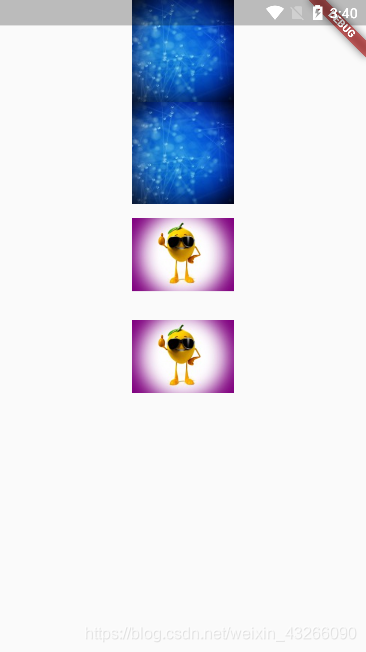3.1 图片的使用
1.源代码
import 'package:flutter/material.dart';
void main () => runApp(MyApp());
class MyApp extends StatelessWidget{
@override
Widget build(BuildContext context ){
return MaterialApp(
title:'All Widget Usages',
home:Scaffold(
body:
Center(
child:
Column(
children: <Widget>[
Image(
image: AssetImage("images/1.jpg"),
width: 100.0,
height: 100.0,
),
Image.asset("images/1.jpg",
width: 100.0,
height: 100.0,
),
Image(
image: NetworkImage("https://img.ivsky.com/img/tupian/t/201411/27/weixiao_de_ningmeng_3d_sheji.jpg"),
width: 100.0,
height: 100.0,
),
Image.network("https://img.ivsky.com/img/tupian/t/201411/27/weixiao_de_ningmeng_3d_sheji.jpg",
width: 100.0,
height: 100.0,
)
],
)
)
),
);
}
}
2.创建文件夹images(将图片丢进去)


3.pubspec.yaml(添加下方代码)
name: flutter_alluse
description: A new Flutter application.
# The following defines the version and build number for your application.
# A version number is three numbers separated by dots, like 1.2.43
# followed by an optional build number separated by a +.
# Both the version and the builder number may be overridden in flutter
# build by specifying --build-name and --build-number, respectively.
# In Android, build-name is used as versionName while build-number used as versionCode.
# Read more about Android versioning at https://developer.android.com/studio/publish/versioning
# In iOS, build-name is used as CFBundleShortVersionString while build-number used as CFBundleVersion.
# Read more about iOS versioning at
# https://developer.apple.com/library/archive/documentation/General/Reference/InfoPlistKeyReference/Articles/CoreFoundationKeys.html
version: 1.0.0+1
environment:
sdk: ">=2.1.0 <3.0.0"
dependencies:
flutter:
sdk: flutter
# The following adds the Cupertino Icons font to your application.
# Use with the CupertinoIcons class for iOS style icons.
cupertino_icons: ^0.1.2
dev_dependencies:
flutter_test:
sdk: flutter
# For information on the generic Dart part of this file, see the
# following page: https://www.dartlang.org/tools/pub/pubspec
# The following section is specific to Flutter.
flutter:
# The following line ensures that the Material Icons font is
# included with your application, so that you can use the icons in
# the material Icons class.
uses-material-design: true
# To add assets to your application, add an assets section, like this:
# assets:
# - images/a_dot_burr.jpeg
# - images/a_dot_ham.jpeg
# 添加如下代码
assets:
- images/1.jpg
# An image asset can refer to one or more resolution-specific "variants", see
# https://flutter.dev/assets-and-images/#resolution-aware.
# For details regarding adding assets from package dependencies, see
# https://flutter.dev/assets-and-images/#from-packages
# To add custom fonts to your application, add a fonts section here,
# in this "flutter" section. Each entry in this list should have a
# "family" key with the font family name, and a "fonts" key with a
# list giving the asset and other descriptors for the font. For
# example:
# fonts:
# - family: Schyler
# fonts:
# - asset: fonts/Schyler-Regular.ttf
# - asset: fonts/Schyler-Italic.ttf
# style: italic
# - family: Trajan Pro
# fonts:
# - asset: fonts/TrajanPro.ttf
# - asset: fonts/TrajanPro_Bold.ttf
# weight: 700
#
# For details regarding fonts from package dependencies,
# see https://flutter.dev/custom-fonts/#from-packages
fonts:
- family: AguafinaScript
fonts:
- asset: fonts/AguafinaScript-Regular.ttf
4.解释源代码
import 'package:flutter/material.dart';
void main () => runApp(MyApp());
class MyApp extends StatelessWidget{
@override
Widget build(BuildContext context ){
return MaterialApp(
title:'All Widget Usages',
home:Scaffold(
body:
Center(
child:
Column(
children: <Widget>[
//Asset第一种方式
Image(
image: AssetImage("images/1.jpg"),
width: 100.0,
height: 100.0,
),
//Asset第二种方式
Image.asset("images/1.jpg",
width: 100.0,
height: 100.0,
),
//Network第一种方式
Image(
image: NetworkImage("https://img.ivsky.com/img/tupian/t/201411/27/weixiao_de_ningmeng_3d_sheji.jpg"),
width: 100.0,
height: 100.0,
),
//Network第二种方式
Image.network("https://img.ivsky.com/img/tupian/t/201411/27/weixiao_de_ningmeng_3d_sheji.jpg",
width: 100.0,
height: 100.0,
)
],
)
)
),
);
}
}
4.效果图
